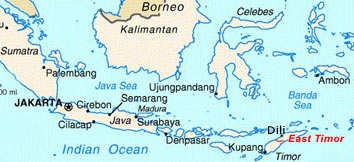East Timor Factsheet
Updated February 21, 2017 | Factmonster Staff 

East Timor Factsheet
Where is East Timor?
East Timor is the eastern part of the island of Timor, which lies between the South China Sea and the Indian Ocean. It is an island in the Indonesian archipelago, located about 400 miles northwest of Australia.
 East Timor and its capital, Dili. |
East Timor and Indonesia
East Timor became a Portuguese colony in the 16th century, while much of the rest of the region was controlled by the Dutch, and known as the Dutch East Indies. The former Dutch colony emerged as the independent Republic of Indonesia in the 1950s, while East Timor remained under Portuguese control until 1975. While 90% of Indonesians are Muslim, the East Timorese are primarily Roman Catholic, a result of Portugese influence.
| Read East Timor's Country Profile |
East Timor was annexed by Indonesia after the Portuguese withdrawal, and its people began an independence movement almost immediately. East Timor's struggle for independence was brutally repressed by Indonesian military forces for over 25 years. More than 200,000 Timorese are reported to have died from famine, disease, and fighting since the annexation.
International Attention on East Timor
The most publicized of Indonesia's conflicts, East Timor has received international attention because of the many reports of human rights abuses. In 1996 two East Timorese activists, Bishop Carlos Filipe Ximenes Belo and José Ramos-Horta, received the Nobel Peace Prize for their efforts to bring about a peaceful resolution to East Timor's situation.
Another internationally known rebel leader, José Alexandre Gusmão, was recently released from an Indonesian prison. He was elected the first president of East Timor in April 2002.
Another internationally known rebel leader, José Alexandre Gusmão, was recently released from an Indonesian prison. He was elected the first president of East Timor in April 2002.
The Independence Referendum
| East Timor President José Alexandre “Xanana” Gusmão |
In Feb. 1999, Suharto's successor, President B. J. Habibie, unexpectedly announced that he was willing to hold a referendum on East Timorese independence. Though many Timorese had long hoped for this news, the sudden Indonesian about-face exacerbated fighting between separatist guerrillas and the paramilitary forces, who are against Indonesia's withdrawal.
Twice rescheduled because of violence, a U.N.-organized referendum to decide whether East Timor would secede from Indonesia took place on Aug. 30, 1999. The East Timorese voted overwhelmingly for independence from Indonesia and when the results were announced, the region descended into a state of anarchy:
Twice rescheduled because of violence, a U.N.-organized referendum to decide whether East Timor would secede from Indonesia took place on Aug. 30, 1999. The East Timorese voted overwhelmingly for independence from Indonesia and when the results were announced, the region descended into a state of anarchy:
- In the days following the election pro-Indonesian militias continued to kidnap, murder, and force the evacuation of local residents. CNN and Reuters reported mass killings and the U.N. reported that up to a third of the population was forced out of the region.
- Aid workers, U.N. workers, and foreign diplomats became targets of the militias. The militias attacked the Australian Consulate, U.N. offices, and even the Australian Ambassador to Indonesia. The U.N. finished evacuating its personnel from East Timor on September 14, 1999, leaving behind a dozen military liason officers.
- Despite repeated assurances that he would restore order to the region, and despite the imposition of martial law, B.J. Habibie was unwilling or unable to restore stability to the region with his country's military forces.
International Response
President B.J. Habibie announced on September 12, 1999, that Indonesia would accept a U.N. peacekeeping force for East Timor. Although some in the Indonesian parliament called for a ban on the involvement of Australia, the United States, New Zealand, and Portugal, Habibie did not impose any conditions on the makeup of the U.N. force.
The UN force was led by Australia and consists of troops from Australia, Britain, Thailand, and several other countries. U.S. involvement was limited to about 200 troops who provided communications and logistical support. "Operation Warden" began with the arrival of the first troops on September 20, 1999, and it met with no resistance from militias or the Indonesian military. The leader of Indonesian forces, Geneneral Wiranto, said the Indonesian army would withdraw in phases and that he planned to turn over the region to the peacekeepers. This withdrawal ended 25 years of Indonesian occupation of East Timor.
The UN force was led by Australia and consists of troops from Australia, Britain, Thailand, and several other countries. U.S. involvement was limited to about 200 troops who provided communications and logistical support. "Operation Warden" began with the arrival of the first troops on September 20, 1999, and it met with no resistance from militias or the Indonesian military. The leader of Indonesian forces, Geneneral Wiranto, said the Indonesian army would withdraw in phases and that he planned to turn over the region to the peacekeepers. This withdrawal ended 25 years of Indonesian occupation of East Timor.
See also:
